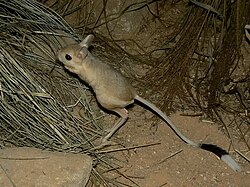Top Qs
Timeline
Chat
Perspective
List of dipodids
Species in mammal family Dipodidae From Wikipedia, the free encyclopedia
Remove ads
Dipodidae is a family of mammals in the order Rodentia and part of the Myomorpha suborder. Members of this family are called dipodids or jerboas. They are found in Asia, northern Africa, and eastern Europe, primarily in deserts, shrublands, and grasslands, though some species can be found in coastal areas or forests. They range in size from the Baluchistan pygmy jerboa, at 4 cm (2 in) plus a 7 cm (3 in) tail, to the great jerboa, at 23 cm (9 in) plus a 30 cm (12 in) tail. Dipodids are omnivores, and eat a variety of vegetation as well as insects, arachnids, and lizards. No dipodids have population estimates, but no species are categorized as endangered.

The 33 extant species of Dipodidae are divided into 13 genera, divided into 4 subfamilies. Allactaginae contains 16 species in 4 genera, Cardiocraniinae contains 7 species in 3 genera, Dipodinae contains 9 species in 5 genera, and Euchoreutinae contains a single species. Several extinct prehistoric dipodid species have been discovered, though due to ongoing research and discoveries, the exact number and categorization is not fixed.[1]
Remove ads
Conventions
The author citation for the species or genus is given after the scientific name; parentheses around the author citation indicate that this was not the original taxonomic placement. Conservation status codes listed follow the International Union for Conservation of Nature (IUCN) Red List of Threatened Species. Range maps are provided wherever possible; if a range map is not available, a description of the dipodid's range is provided. Ranges are based on the IUCN Red List for that species unless otherwise noted.
Remove ads
Classification
Summarize
Perspective
Dipodidae is a family consisting of 33 extant species in 13 genera. These genera are divided into four subfamilies: Allactaginae, containing 16 species in 4 genera; Cardiocraniinae, containing 7 species in 3 genera; Dipodinae, containing 9 species in 5 genera; and Euchoreutinae, containing a single species. This does not include hybrid species or extinct prehistoric species.
Family Dipodidae
- Subfamily Allactaginae
- Genus Allactaga (five-toed jerboas): eight species
- Genus Allactodipus (Bobrinski's jerboa): one species
- Genus Pygeretmus (fat-tailed jerboas): three species
- Genus Scarturus (four- and five-toed jerboas): four species
- Subfamily Cardiocraniinae
- Genus Cardiocranius (five-toed pygmy jerboa): one species
- Genus Salpingotulus (Baluchistan pygmy jerboa): one species
- Genus Salpingotus (three-toed dwarf jerboas): five species
- Subfamily Dipodinae
- Genus Dipus (northern three-toed jerboa): one species
- Genus Eremodipus (Lichtenstein's jerboa): one species
- Genus Jaculus (desert jerboas): three species
- Genus Paradipus (comb-toed jerboa): one species
- Genus Stylodipus (thick-tailed three-toed jerboas): three species
- Subfamily Euchoreutinae
- Genus Euchoreutes (long-eared jerboa): one species
Remove ads
Dipodids
Summarize
Perspective
The following classification is based on the taxonomy described by the reference work Mammal Species of the World (2005), with augmentation by generally accepted proposals made since using molecular phylogenetic analysis, as supported by both the IUCN and the American Society of Mammalogists.[3]
Subfamily Allactaginae
Subfamily Cardiocraniinae
Subfamily Dipodinae
Subfamily Euchoreutinae
Remove ads
References
Sources
Wikiwand - on
Seamless Wikipedia browsing. On steroids.
Remove ads



















